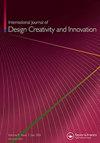极端的用户条件,以提高设计的创造力和同理心-应用使用视觉障碍
IF 2.5
Q4 ENGINEERING, MANUFACTURING
International Journal of Design Creativity and Innovation
Pub Date : 2022-01-11
DOI:10.1080/21650349.2021.2024093
引用次数: 6
摘要
摘要经历身体、感官或认知挑战的极端用户可以帮助识别大多数普通用户的潜在需求。识别这些潜在需求可能会为新产品、服务和系统打开大门。模拟工具和场景的移情设计技术使设计师能够体验到一系列极端的用户视角。然而,研究仍然缺乏对此类技术的潜在影响的彻底理解,尤其是它们揭示和解决潜在需求的潜力。本文通过分析两个以用户为中心的研讨会来加强对模拟工具和场景的理解,这两个研讨会应用模拟场景与视觉障碍用户进行移情,并使用移情相似性度量来评估移情结果和自我评估的移情。除了同理心之外,还对36名(x2)研讨会参与者和13名VI参与者共享的概念进行了创造力测量。对两组对照研究结果的实证分析支持了模拟场景在激发参与者创造力和同理心方面的潜力。同理心:能够不加评判地理解和分享他人的感受。模拟:对过程、情况或环境的模仿。场景:用户经历的特定于上下文的(如何、在哪里和谁)情况。潜在需求:对普通用户来说很重要但并不明显的需求(Otto&Wood,1998)。极限用户:体验身体或认知能力挑战的用户。普通人群:不符合极端使用者资格的剩余人群。本文章由计算机程序翻译,如有差异,请以英文原文为准。
Extreme-user conditions to enhance design creativity and empathy- application using visual impairment
ABSTRACT Extreme-users who experience physical, sensory or cognitive challenges can help identify latent needs across a majority of the general population users. Identifying these latent needs may open doors to novel products, services, and systems. Empathic design techniques of simulation tools and scenarios allow designers to experience a range of extreme-user perspectives. However, research still lacks a thorough understanding of the potential impact of such techniques, especially their potential to uncover and address latent needs. This paper strengthens the understanding of simulation tools and scenarios by analyzing two user-centered workshops that applied simulated scenarios to empathize with users with visual impairments (VIs), and uses an empathic similarity metric to evaluate the empathic outcomes in conjunction with self-evaluated empathy. In addition to empathy, creativity is measured for the concepts shared by 36 (x2) workshop participants and 13 participants with VIs. Empirical analysis of the results, across two sequences of controlled studies, supports the potential of simulated scenarios in evoking participant creativity and empathy. KEY TERMINOLOGIES Empathy: Ability to understand and share feelings of others without judgment. Simulation: Imitation of a process, situation, or circumstance. Scenario: Context-specific (how, where, and who) circumstances experienced by users. Latent Needs: Needs that are important yet not obvious to the average user (Otto & Wood, 1998). Extreme-Users: Users who experience challenges with physical or cognitive abilities. General Population: The remainder of the population who do not qualify as extreme-users.
求助全文
通过发布文献求助,成功后即可免费获取论文全文。
去求助
来源期刊

International Journal of Design Creativity and Innovation
ENGINEERING, MANUFACTURING-
CiteScore
3.80
自引率
27.80%
发文量
15
期刊介绍:
The International Journal of Design Creativity and Innovation is an international publication that provides a forum for discussing the nature and potential of creativity and innovation in design from both theoretical and practical perspectives. Design creativity and innovation is truly an interdisciplinary academic research field that will interest and stimulate researchers of engineering design, industrial design, architecture, art, and similar areas. The journal aims to not only promote existing research disciplines but also pioneer a new one that lies in the intermediate area between the domains of systems engineering, information technology, computer science, social science, artificial intelligence, cognitive science, psychology, philosophy, linguistics, and related fields. The journal covers, but is not restricted to, the following topics: ·Theories on Design Creativity and Innovation ·Cognition of Design Creativity ·Innovative Process ·Inventive Process ·Analogical Reasoning for Design Creativity and Innovation ·Design Synthesis ·Method and Tools for Design Creativity and Innovation ·Representation of Design Creativity and Innovation ·Education for Design Creativity and Innovation ·Concept Generation and Inspiration.
 求助内容:
求助内容: 应助结果提醒方式:
应助结果提醒方式:


